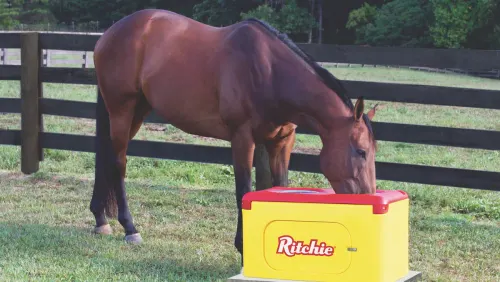The Veterinary Corner series, brought to you by Merck Animal Health, features insights from leading veterinarians on some of the most pressing health issues affecting horses today.
By Duane E. Chappell, DVM, Merck Animal Health
With show season in full swing, so is the chance of equine respiratory disease spread. While cutting off potential disease begins well before you leave home, it’s also crucial to know what’s circulating to stay armed with information and tools to stay ahead of an outbreak. Enter the Equine Biosurveillance Program.
What Is The Equine Biosurveillance Program?
Since 2008, Merck Animal Health has partnered with the University of California, Davis, School of Veterinary Medicine on the Equine Biosurveillance Program, a voluntary project in which veterinarians and researchers collaborate to monitor equine respiratory disease in horses nationwide. The program monitors four main pathogens:
- Equine herpesvirus types 1 and 4 (EHV-1, EHV-4): These respiratory viruses cause symptoms ranging from mild to severe; EHV-1 can also cause late-term abortions, early foal death and neurologic disease.
- Equine influenza virus (EIV): This highly contagious “flu” virus can cause fever, coughing, nasal discharge and lethargy.
- Streptococcus equi subspecies equi (S. equi or strangles): S. equi is a bacterium that causes strangles, a highly contagious disease that produces abscesses in the lymph nodes of the head and neck, as well as fever and nasal discharge.
- Equine rhinitis A/B viruses (ERAV/ERBV): These viruses infect horses’ respiratory tracts, with symptoms including fever, nasal discharge and coughing.
At the heart of the Equine Biosurveillance Program lies a commitment to four main goals:
- Help equine veterinarians diagnose and treat infectious respiratory diseases as quickly as possible.
- Help the horse industry understand how common these respiratory pathogens are, how they spread, and why they affect some horses more than others.
- Identify and monitor the latest pathogen strains currently circulating.
- Evaluate how well current vaccination protocols are working.
ADVERTISEMENT
What Diseases Are Trending?
A key finding of the Biosurveillance Program has been the identification of EHV-4 and EIV as the most common upper respiratory pathogens affecting horses. These viruses have made up the largest proportion of positive sample results in the past 16 years. However, the program has also been tracking an uptick in S. equi (strangles) in the past two years, making it the most prevalent pathogen tested in 2023.
The Biosurveillance Program also tracks the time of year when pathogens are most prevalent (see “Respiratory Disease Incidence in 2023”), which helps veterinarians figure out the best times to vaccinate—as well as what measures will help keep disease from spreading among horses. Across 16 years of surveillance, EHV-4 continues to be more prevalent in the fall months, while the other respiratory pathogens (especially EIV) are more common in the winter and spring months.
The program also underscores the fact that vaccination alone isn’t enough to provide complete protection, especially for highly contagious diseases like equine herpesvirus, influenza and S. equi. For the highest level of protection, horse owners and handlers must follow sound biosecurity practices to provide a broader net of disease protection.
How Does The Program Impact Me and My Horse?
If your horse contracts a respiratory disease, it’s important that your veterinarian diagnose it quickly and start appropriate treatment, and that you work together to prevent the spread of the disease to other horses in the area. Since many upper respiratory diseases share similar signs and symptoms (see “Top Respiratory Pathogen Symptoms”), this can be a challenge.
Top Respiratory Pathogen Symptoms

To be included in the Merck Animal Health Biosurveillance Program, a sample must come from a horse with a fever of at least 101.5° F. Other symptoms often include:
- Nasal discharge
- Coughing
- Lethargy
- Central nervous system problems
These signs of disease are more or less common depending on the infectious organism causing them, but they are prevalent across equine respiratory illnesses.
ADVERTISEMENT
That’s why the program provides tools to help veterinarians collect nasal swab samples from a sick horse quickly and efficiently, submit them for evaluation to a qualified laboratory, and arrive at a diagnosis quickly—so they can create the best treatment plan for their patients.
If your veterinarian is a participant in the Biosurveillance Program, they receive results within 24 to 36 hours of submitting a sample, along with expert input to help treat the patient effectively. This quick turnaround gives your veterinarian an excellent chance to not just manage individual cases but shut down potential outbreaks successfully.
By working with veterinarians to collect samples in this way, the Biosurveillance Program has amassed the largest collection of equine infectious upper respiratory data in the United States. To date, more than 12,000 samples have been submitted from veterinarians across the United States representing horses of all ages, sexes and breeds. This extensive dataset has proved pivotal for advancing horse health care to date and will only boost equine health outcomes in the future.
Another significant contribution of the Biosurveillance Program has been the identification and isolation of Florida ’13. This highly pathogenic strain of influenza is considered the most current, clinically significant strain and is available only in Merck Animal Health’s PRESTIGE® vaccines.
Several scientific publications and presentations have been generated from the data to educate the larger equine community. Participating veterinarians receive updates from the data twice yearly to guide their practice decisions and provide timely updates for horse owners.
An Unconditional Promise
The Merck Animal Health Equine Biosurveillance Program is part of the company’s Unconditional commitment to horses and the people who love and care for them. As you can see, that commitment goes far beyond developing innovative equine health products. It also powers some of the most innovative research programs impacting the equine industry today.
Reference
1Merck Animal Health and University of California, Davis (Nicola Pusterla). Infectious Upper Respiratory Disease Surveillance Program. Ongoing research 2008–present.
About The Author
Duane E. Chappell, DVM, Associate Director, Equine Pharmacovigilance and Professional Services at Merck Animal Health, has a background in academia, equine research and private practice. Dr. Chappell and the Veterinary Professional Services team support the Equine Respiratory Biosurveillance Program by partnering with scientists at UC Davis to publish timely industry updates and peer-reviewed publications.
***This is a paid promotion. COTH staff had no involvement in the creation of this content***















